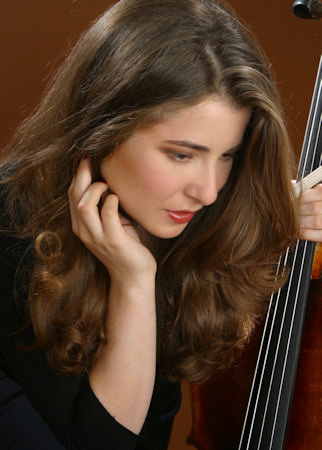Other Links
Editorial Board
-
Editor - Bill Kenny
Assistant Webmaster - Stan Metzger - Founder - Len Mullenger
Google Site Search
SEEN AND HEARD INTERNATIONAL CONCERT REVIEW
Shostakovich, Lera Auerbach:
Alisa Weilerstein, cello; Lera Auerbach, piano, presented by San Francisco Performances, Herbst Hall, San Francisco, 6.4.2010 (HS)

Alisa Weilerstein – Picture © Christian Slater
It takes a composer of poise and daring to take on a form associated primarily with J.S. Bach, who worked his way through all 24 major and minor keys in his Well-Tempered Klavier, a series of preludes or fugues. Chopin did it with his preludes, and Dmitri Shostakovich constructed his own set of preludes in 1932. Composer and pianist Lera Auerbach got her first taste of this form when the violinist Grigory Kalinovsky commissioned her in 1999 to complete the 19 Shostakovich piano preludes already arranged for piano and violin by Dmitri Tsyganov.
Inspired by that, Auerbach set about writing a complete piano cycle of her own, and performed it that same year 1999 in New York. Like Shostakovich, she went through the keys in a circle of fifths (instead of the half-steps of Bach), and infused the music with a range of emotions, including plenty of sharp Russian wit. She was having so much fun, she told a rapt audience at Herbst Hall in San Francisco Tuesday night, that she wrote another set for violin and piano, and a third set for cello and piano, all in 1999.
And there they sat, unperformed, until the Hamburg ballet presented a dance to the violin and cello preludes in 2003. She debuted the violin set with Vadim Gluzman in San Francisco in 2004, and later they recorded it. But the cello work did not see the concert hall until 2008, when the phenomenal American cellist Alisa Weilerstein teamed up with Auerbach to present it at the Caramoor Festival.
In an amazingly apt and daring pairing, Auerbach and Weilerstein preceded the performance of Auerbach’s Twenty-Four Preludes for Violoncello and Piano with Auerbach’s arrangement for cello and piano of Shostakovich’s Twenty-Four Preludes, Op. 34. It made for an immensely satisfying concert.
Weilerstein, all of 27 years old, is a chameleon on the cello. She can make it sing sweetly and guilelessly one moment, shift to ethereal harmonics the next, and then dig the bow into the strings near the bridge for a harsh sound that somehow avoids being vulgar. The rainbow of colors she draws from the instrument combine with an innate instinct for the musical line to make emotional poetry. That is exactly what a musician needs to perform Shostakovich and, it turns out, spurs Auerbach’s own music to life.
And life is what the 36-year-old composer’s music is all about. The two dozen short pieces in this work are written in an accessible style that lets the expressiveness come through. In one particularly poignant moment, the cellist imposes a series of variations on a lyrical theme that might have come from Tchaikovsky’s pen. Excessive portamento introduces a sickly quality to the tune, suggesting a protagonist getting drunk, or perhaps realizing that the romantic partner is not who she thought he was. Then, playing the tune in high harmonics, it sounds elegiac.
Those high harmonics return for the next-to-last prelude, made even more evanescent by playing them muted, producing a ghostly feeling. At other turns, the music turns rough and muscular, with a rhythmic bite peculiar to Russian composers. The piece opens with a declamatory theme that comes off rather like an off-kilter march.
Auerbach’s piano writing is just as colorful. Although it usually acts as a frame for the cello’s line, it has its moments, too. At one point it sparkles in the background of a lovely line in the cello. At another it pounds angrily as the rhythm stomps.
This all adds up to a kaleidoscope of ideas and powerfully emotional moments, calling to mind a series of short poems. Amazingly, Auerbach knits them together. It isn’t the purely musical material but the performance choices—bowing near the bridge, those high harmonics, a penchant for going to the extremes of the cello’s range—that make the two dozen preludes somehow coalesce into an arc. Weilerstein has the technique and musicality to make it happen, flawlessly.
By adding the cello’s colors, Auerbach’s arrangement of the Shostakovich preludes sometimes soften the hard edges of the music, at other times adding a welcome breadth to the long-breathed passages. It really becomes a different piece from the solo piano original, certainly more rich in texture if somewhat less sardonic.
For an encore, Weilerstein and Auerbach played Postlude, based on the same gorgeous tune that goes awry in the full set, only staying sober this time. It made a perfect finish.
Harvey Steiman
